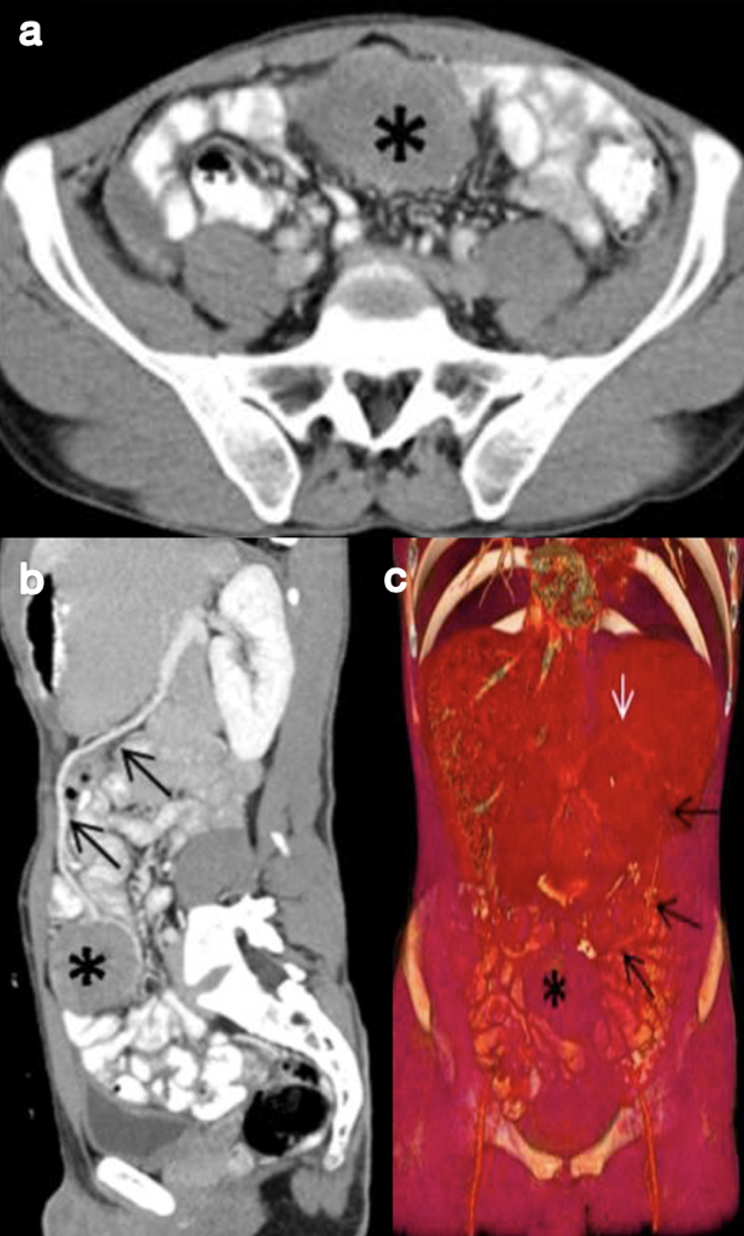Omental Necrosis and Mesenteric Ischemia Secondary to Hypercoagulability Due to COVID-19: A Case Report
DOI:
https://doi.org/10.38179/ijcr.v3i1.89Keywords:
Necrosis, Omentum, COVID-19, Hypercoagulability, Case ReportAbstract
Background: Omentum necrosis is a rare cause of acute abdomen. Its main etiologies are torsion on its axis, hypercoagulability, and intra-abdominal infections. Its clinical diagnosis is difficult since its symptoms resemble other abdominal pathologies, so diagnostic confirmation when the pain is present in the right abdomen, which occurs most frequently, is usually intraoperative Surgical treatment is more effective than conservative management in reducing hospital stays and does not require follow-up.
Case Report: We present the case of a 45-year-old male suspected to be infected with SARS-CoV-2, which potentially triggered hypercoagulability with necrosis of the greater omentum and mesenteric ischemia, requiring multiple surgical interventions.
Conclusion: It is a rare cause of acute abdomen and to the best of our knowledge, the description of the first case of necrosis of the omentum secondary to COVID-19.
References
Eitel GG. Rare Omental Torsion. New York Med Rec.1899;55:715.
Medina-Gallardo NA, Curbelo-Peña Y, Stickar T, et al. OMENTAL INFARCTION: SURGICAL or CONSERVATIVE TREATMENT? A CASE REPORTS and CASE SERIES SYSTEMATIC REVIEW. Ann Med Surg (Lond). 2020;56:186-193.
PMID:32642061. https://doi.org/10.1016/j.amsu.2020.06.031
Breunung N, Strauss P. A diagnostic challenge: primary omental torsion and literature review - a case report. World J Emerg Surg. 2009;4:40. PMID: 19922627. https://doi.org/10.1186/1749-7922-4-40
Zaleta-Cruz JL, Rojas-Méndez J, Garza-Serna U, González-Ruvalcaba R, de Elguea-Lizarraga JO, Flores-Villalba E. Torsión de epiplón. Reporte de caso. Cirugía y Cirujanos, 2017;85(1):49-53. https://doi.org/10.1016/j.circir.2015.08.008.
Ng LF, Hibberd ML, Ooi EE, et al. A human in vitro model system for investigating genome-wide host responses to SARS coronavirus infection. BMC Infect Dis. 2004;4:34. Published 2004 Sep 9. PMID: 15357874. https://doi.org/10.1186/1471-2334-4-34
Chowdhury JF. Moores LK, Connors, JM. Anticoagulation in Hospitalized Patients with Covid-19.. NEJM. 2020; 383:1675-1678. New England Journal of Medicine October 22, 2020 383(17):1675. https://doi.org/10.1056/NEJMclde2028217
Shi C, Tingting W, Li JP, et al. Comprehensive Landscape of Heparin Therapy for COVID-19. Carbohydr Polym. 2021;254:117232. PMID: 33357843. https://doi.org/10.1016/j.carbpol.2020.117232
Vivas D, Roldán V, Esteve-Pastor MA, et al. Recomendaciones sobre el tratamiento antitrombótico durante la pandemia COVID-19. Posicionamiento del Grupo de Trabajo de Trombosis Cardiovascular de la Sociedad Española de Cardiología [Recommendations on antithrombotic treatment during the COVID-19 pandemic. Position statement of the Working Group on Cardiovascular Thrombosis of the Spanish Society of Cardiology]. Rev Esp Cardiol. 2020;73(9):749-757. PMID: 32327870. https://doi.org/10.1016%2Fj.recesp.2020.04.006
Drago F, Gozzo L, Li L, Stella A, Cosmi B. Use of Enoxaparin to Counteract COVID-19 Infection and Reduce Thromboembolic Venous Complications: A Review of the Current Evidence. Front Pharmacol. 2020;11:579886. PMID: 33041824. https://doi.org/10.3389/fphar.2020.579886
Nadeem R, Thomas SJ, Fathima Z, et al. Pattern of anticoagulation prescription for patients with Covid-19 acute respiratory distress syndrome admitted to ICU. Does it impact outcome?. Heart Lung. 2021;50(1):1-5. PMID: 33138975. https://doi.org/10.1016/j.hrtlng.2020.10.009
Karcaaltincaba M, Eldem G, Ozdeniz I, Akata D, Ozmen M, Akhan O. Omental vascular pedicle sign: Multidetector CT finding useful for diagnosis of an omental mass. European Journal of Radiology. 2012;81(2):166-169. https://doi.org/10.1016/j.ejrad.2011.01.043. http://www.sciencedirect.com/science/article/pii/S0720048X11000726
Yagnik VD. Primary omental torsion. ANZ J Surg. 2019;89(11):1515-1516. PMID: 30497099. https://doi.org/10.1111/ans.14952
Helms J, Tacquard C, Severac F, et al. High risk of thrombosis in patients with severe SARS-CoV-2 infection: a multicenter prospective cohort study. Intensive Care Med. 2020;46(6):1089-1098. PMID: 3236717. https://doi.org/10.1007%2Fs00134-020-06062-x
Tang N, Bai H, Chen X, Gong J, Li D, Sun Z. Anticoagulant treatment is associated with decreased mortality in severe coronavirus disease 2019 patients with coagulopathy. J Thromb Haemost. 2020;18(5):1094-1099. PMID: 32220112. https://doi.org/10.1111/jth.14817

Published
How to Cite
Issue
Section
Copyright (c) 2022 International Journal of Clinical Research

This work is licensed under a Creative Commons Attribution 4.0 International License.







